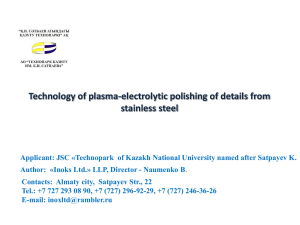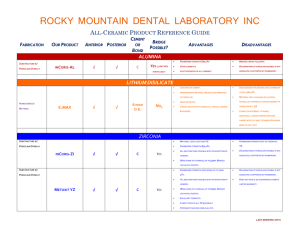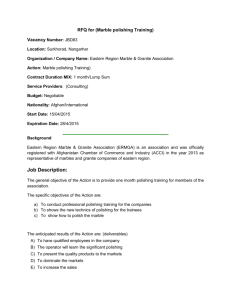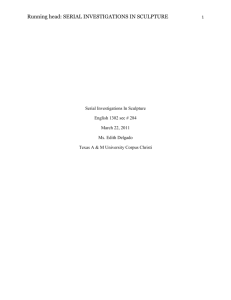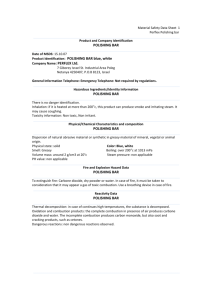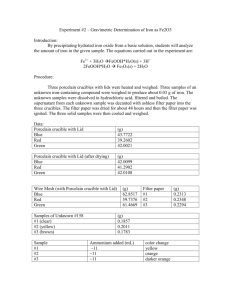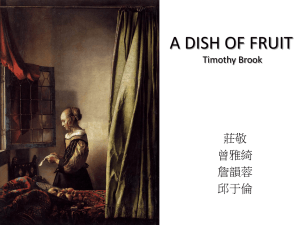Original Articles
advertisement
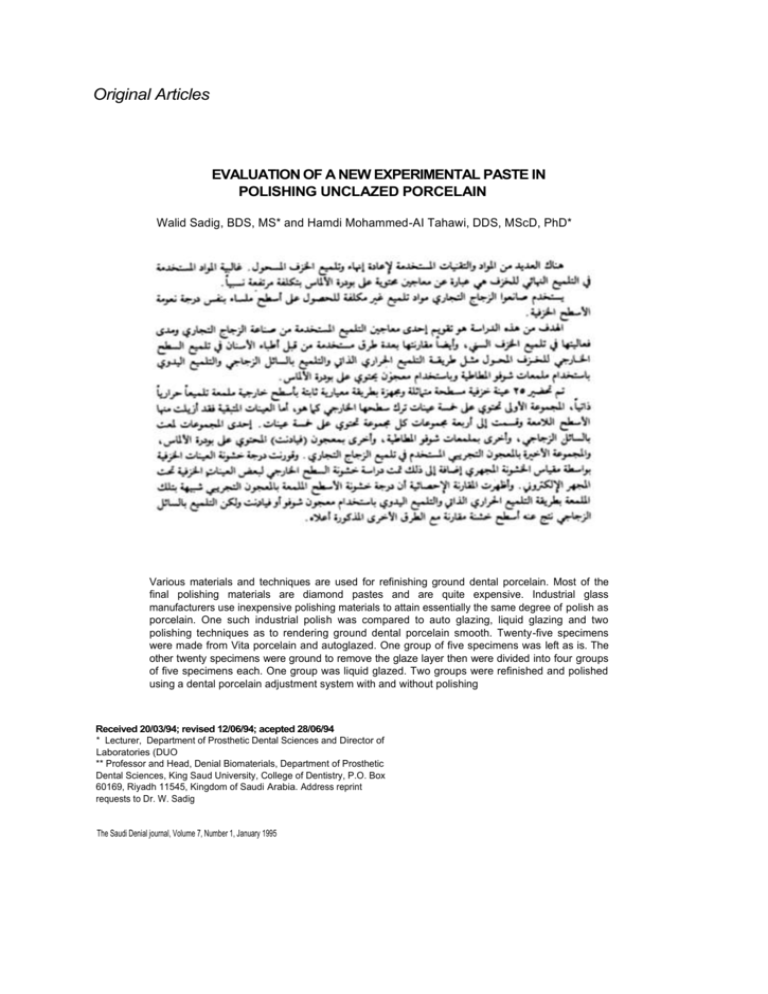
Original Articles
EVALUATION OF A NEW EXPERIMENTAL PASTE IN
POLISHING UNCLAZED PORCELAIN
Walid Sadig, BDS, MS* and Hamdi Mohammed-AI Tahawi, DDS, MScD, PhD*
Various materials and techniques are used for refinishing ground dental porcelain. Most of the
final polishing materials are diamond pastes and are quite expensive. Industrial glass
manufacturers use inexpensive polishing materials to attain essentially the same degree of polish as
porcelain. One such industrial polish was compared to auto glazing, liquid glazing and two
polishing techniques as to rendering ground dental porcelain smooth. Twenty-five specimens
were made from Vita porcelain and autoglazed. One group of five specimens was left as is. The
other twenty specimens were ground to remove the glaze layer then were divided into four groups
of five specimens each. One group was liquid glazed. Two groups were refinished and polished
using a dental porcelain adjustment system with and without polishing
Received 20/03/94; revised 12/06/94; acepted 28/06/94
* Lecturer, Department of Prosthetic Dental Sciences and Director of
Laboratories (DUO
** Professor and Head, Denial Biomaterials, Department of Prosthetic
Dental Sciences, King Saud University, College of Dentistry, P.O. Box
60169, Riyadh 11545, Kingdom of Saudi Arabia. Address reprint
requests to Dr. W. Sadig
The Saudi Denial journal, Volume 7, Number 1, January 1995
EXPERIMENTAL PASTE IN POLISHING UNGLAZED PORCELAIN
paste. The last group was refinished but polished with an industrial glass polishing paste.
Roughness of the specimen surfaces were determined by using a surface roughness microanalyzer.
Specimens from each group were examined under the SEM. Statistical analysis showed that the
industrial glass polish produced a surface as smooth as the autoglazed surface and as two of the
porcelain polishing techniques. Liquid glazing produced a surface significantly more rough than
the other four treatments.
Introduction
Materials and Methods
Porcelain has been available as a restorative material
for over 150 years.' The material is widely used
mainly because of its aesthetic qualities. There are
numerous instances in laboratory and clinical practice
when it is necessary to adjust an autoglazed
porcelain surface by grinding.2 The resulting break in
the glazed surface need not be ignored. Monasky and
Taylor3 demonstrated an increased potential for wear
of occlusal surfaces opposed by a ground porcelain
surface. Podshadley and Harrison4 reported that an
unglazed porcelain surface in contact with soft
tissues can elicit an unfavorable response. Hence,
ground porcelain surfaces, if not glazed, should be
polished thoroughly to eliminate the rough surface
layer.5 Various techniques have been used for
refinishing ground porcelain6 and several porcelain
refinishing diamond pastes are now available
commercially. These diamond pastes are capable of
restoring adjusted porcelain to a degree of surface
smoothness comparable to that of glazed
porcelain.7"9 Actually, many ceramists advocate
polishing, rather than glazing, to control the surface
luster, glossiness and the aesthetic result of the
ceramic restoration.10 However, these commercial
pastes are expensive.
Industrial glass manufacturers consume an
abundance of polishing agents for the purpose of
finishing and polishing their products. These
polishing agents are readily available and quite
inexpensive.
The purpose of this study was to evaluate the
effectiveness of one of the industrial glass polishing
agents in refinishing ground dental porcelain surface.
Further, the efficiency of the glass polishing agent
relative to four porcelain finishing techniques is
compared, both quantitatively and qualitatively.
Twenty-five porcelain specimens were made using
Vita VMK-68 porcelain* of which each specimen was
1 xl x 0.4 cm in size. The specimens were prepared in a
standardized manner. Each specimen was fired in an
aluminum split mold and autoglazed at 940°C. All
specimens were prepared in one batch using the
same furnace and according to the manufacturer's
directions. The specimens were divided randomly
into five groups, each consisting of five
specimens.8,11 Each specimen was embedded in an
acrylic block to facilitate a firm grip during polishing.
In group 1 (AC) no treatment was provided; the
surface was left with the autoglazed layer. The
surfaces of the four remaining groups were ground
with an abrasive stone** to remove the glazed layer.
Grinding was performed in one direction and always
at 90°C angle to the previous polishing direction to
obtain undirectional abrasion marks on porcelain.
Specimens in Group
2 (LG) were then glazed with a liquid glaze.*** Group
3 (SH) was refinished with Shofu porcelain polishing
kit.**** Specimens in Group 4 (VV) were refinished
with a diamond impregnated rubber disk then
polished with Vident porcelain finishing paste.*****
Specimens in Group 5 (GS) were finished with a
diamond impregnated rubber disk (Vident) then
polished with a creamy consistency of the
experimental
polishing
powder
[Gaylussite
Na2Ca(CO3)2.5 H2O; white, grayish Monoclinic with a
specific gravity of 1.991 and hardness of 2.5 - 3]
using a rag wheel.
The Saudi Dental journal, Volume 7, Number 1, January 1995
*Vita Bad Sackingen, Germany
**Ash, Alpine, Detrey, GmbH
***Vitachrome 1725, Vita
**** Shofu Dental Corp., Menlo Park, California, USA
****** Vident, Baldwin Park, California, USA t Surtronic 3, Rank
†Taylor, Hobson, Leicester, England
‡Jeol, JSM-T330A Scanning Microscope, Jeol Ltd., Nakagami
Akishima, Tokyo, Japan
SADICANDAL-TAHAWI
To simulate a clinical situation, no attempt was
made to control the speed or pressure of the polishing
handpiece. Each finishing step was continued for a
reasonable amount of time (less than 5 minutes for
each sample) until the surface appeared smooth
when viewed by the investigators under X5
magnifying glass. This approach to sample polishing
was consistent with literature.10'11 Specimens were
cleaned in an ultrasonic bath for 15 minutes using tap
water. The surface roughness was measured using a
surface roughness microanalyzer.t Three parallel
scans, 2 mm apart, were made of each specimen
using the parameter Ra (Ra = mean roughness = sum
of elevations + depressions -r sampling length). The
cut-off value was 0.8 mm with a traverse length of
4.90 mm and a drive speed of 0.25 mm/sec. Two
specimens from each group were viewed under a
SEMtt and photographed at a magnification of
X1500.
mean roughness was that of the autoglazed
porcelain. The mean roughness obtained as a result
of using the Shofu and Vident pastes were equal to
each other and quite close to that of the industrial
glass polish. The latter three polishing materials
resulted in a surface that has a higher mean
roughness than that obtained by autoglazing but
much smoother than that obtained from a liquid
glazed surface.
One way analysis of a variance {ANOVA} (Table
2) showed that significant differences exist between
the five means. Multiple range analysis (Table 3)
showed that there was no difference in surface
roughness among four treatments and all of them
were significantly different (P < .05) from the liquid
glazed surface.
SEM examination revealed that the liquid glazed
surface [Fig. 1] is much rougher than surfaces treated
by the other four methods.
Table 1. Mean roughness and confidence intervals for five treatments.
Group
Treatment
Specimen Count
Mean Roughness
Standard Error
(Internal)
95 % LSD Intervals for Mean
1
AC
5
.3000000
.0836660
.1495426
.4504574
2
LC
5
1.1200000
.1772005
.9695426
1.2704574
3
SH
5
.5000000
.0316228
.3495426
.6504574
4
VV
5
.5000000
.0632456
.3495426
.6504574
5
GS
5
.4600000
.0927362
.3095426
.6104574
5
Totals
25
.5760000
.0456070
.5087134
.6432866
Table 2. Results of one-way analysis of variance.
A n a l y s i s of V a r i a n c e
Source of Variation
Sum of Squares
D. F.
Mean Square
Between groups
1.9856000
42
.4964000
Within groups
1.040000
0
.052000
Total (Corrected)
3.0256000
F - ratio
Significance Level
9.546
-
.0002
-
24
Table 3. Multiple range analysis for surface roughness.
Method: 95% LSD Intervals
Results
The mean roughness, standard error of mean and
95% confidence interval for each of the autoglazed
(AC), the liquid glazed (LG), the Shofu polished
(SH), the Vident polished (VV), and the industrial
glass polishing paste (GS) specimens are shown in
Table 1. The table shows that the lowest
The Saudi Dental lournal, Volume 7, Number 1, January 1995
Treatment
Count
Average
Homogenity +
AC
5
.3000000
*
LG
SH
VV
GS
5
5
5
1.1200000
.5000000
.5000000
.4600000
*
*
*
5
*
'Asterisks on top of each other indicate no significant difference, j
EXPERIMENTAL PASTE IN POLISHING UNGLAZED PORCELAIN
Figure 1. Representative scanning electron photomicrographs
revealing smoothness of autoglazed (a), liquid glazed (b), Shofu
polished (c), Vident paste polished (d), and experimental paste
polished surfaces (e).
Discussion
Different polishing techniques for porcelain have
been studied using both methods of this study. 1'6-8-11
The polishing techniques were also evaluated by SEM
alone2'9-12 or by a magnifying glass.2 In many previous
studies1-8 12 no differences were found between the
autoglazed and polished porcelain surfaces. These
reports are in agreement with our study where two
porcelain polishing techniques and one industrial
glass polishing paste produced smooth surfaces
which was statistically not different from an
autoglazed surface. Obviously, not all post-grinding
porcelain polishing methods are capable of restoring
the smoothness of a ground porcelain surface to its
autoglazed condition since the liquid glazing
technique tested by us failed to do so. However,
many ceramists believe that liquid glazing creates
comparable smoothness to autoglazing, when it is
not. Nevertheless, a more recent study showed that
liquid glazing significantly increased the flexural
strength of feldspathic porcelain.13 It is quite
interesting to note that the inexpensive industrial
glass polishing agent was as effective as professional
dental porcelain polishing agents in polishing ground
dental porcelain.
One must keep the issue of surface smoothness in
perspective, however. While a ground then
polished porcelain may be as smooth as an
autoglazed porcelain, there are clinical functional
differences.14 McLean stated that a ground
The Saudi Dental Journal, Volume 7, Number 1, January 1995
SADIG AND AL-TAHAWI
porcelain surface that is not reglazed will cause
impairment of fracture resistance.15'16 However,
McLean's methods of specimen preparation differed
from the clinical situation. His specimens were
hydraulically pressed from powder, the level of glaze
used was higher than that used when matching the
luster of natural teeth, and a medium-fusing porcelain
rather than low-fusing metal ceramic porcelain was
tested. In 1959, Hodson17 reported that grinding
glazed high- and medium-fusing porcelains reduced
the modules of rapture but grinding low-fusing
specimens did not. More recently in 1989,
Rosensteil10 found that the fracture toughness
increased by using polishing as an alternative to
autoglazing. Another study showed that fracture
toughness increased by 22% when polishing was
applied. In addition, the stainability was unaffected.'3
The author considered the results unexpected.
Porcelain polishing is practiced more routinely
especially after the introduction of porcelain
veneers, inlays and onlays.18
It was further pointed out that an unglazed occlusal
surface will cause more occlusal wear of opposing
teeth than will a glazed surface.3 It appears that good
polishing ameliorates all negative effects of
unglazing.
Conclusions
Based on the findings of this study, the authors
conclude that:
1. An inexpensive industrial glass polishing agent
was as effective as dental porcelain polishing
agents in producing a smooth and glossy dental
porcelain surface - be it an autoglazed or ground
surface.
2. Liquid glazing may fill surface flaws but it was not
as capable as mechanical polishing agents in
restoring surface smoothness.
3.
Even though ceramists polish their porcelain
more routinely, fracture properties need to be
further considered in future studies.
The Saudi Dental Journal, Volume 7, Number 1, January 1995
References
1.
Klausner LH, Cartwright CB, Charbaneau GT. Polished
versus autoglazed porcelain surfaces. ) Prosthet Dent
1982;47:157-61.
2. Sulik WD, Plekavich EJ. Surface finishing of dental porcelain.
J Prosthet Dent 1981 ;46:21 7-21.
3. Monasky GE, Taylor DF. Studies on the wear of porcelain,
enamel and gold.) Prosthet Dent 1971 ;25:299-306.
4. Podshadley AC, Harrison JD. Rat connective tissue response
to pontic materials. ) Prosthet Dent 1966;16:110.
5.
Henry PJ, Johnston JF, Mitchell DF. Tissue changes
beneath fixed partial dentures. J Prosthet Dent
1966;16:937-47.
6.
Smith GA, Wilson NH. The surface finish of trimmed
porcelain. BrDentJ 1981 ;151:222-24.
7.
Newitter DA, Schlissel ER, Wolff MS. An evaluation of
adjustment and postadjustment finishing techniques on the
surface of porcelain-bonded-to-metal crowns. J Prosthet
Dent 1982:48:388-95.
8.
Patterson CJ, McLundie AC, Stirrups DR, Taylor WG.
Refinishing of porcelain by using a refinishing kit. J Prosthet
Dent 1991, 65:383-88.
9.
Raimondo RL Jr, Richardson JT, Wiedner B. Polished
versus autoglazed dental porcelain. J Prosthet Dent
1990;64:553-57.
10. Rosensteil SF, Baiker MA, Johnston WM. A comparison of
glazed and polished dental porcelain. Int J Prosthodont
1989:2:524-29.
11. Goldstein GR, Barnhard BB, Penugonda B. Profilometer, SEM,
and visual assessment of porcelain polishing methods.)
Prosthet Dent 1991 ;65:627-34.
12.
Schlissel ER, Newitter DA, Renner RR, Gwinnet A). An
evaluation of post-adjustment polishing techniques for
porcelain denture teeth.) Prosthet Dent 1980;43:258-65.
13.
Giordano RA, Campbell S, Pober R. Flexural strength of
feldspathic porcelain treated with ion exchange, overglaze
and polishing. J Prosthet Dent 1994;71:468-72.
14.
Morrow RM, Brown CE, Larkin JD, Bernut R, Rudd KD.
Evaluation of methods for polishing porcelain denture teeth.
J Prosthet Dent 1973;30:222-26.
15. McLean JW. Science and art of dental ceramics. Volume I.
The nature of dental ceramics and their clinical use. 2nd ed.
Berlin:Quintessence Publ Co, 1979:263.
16.
McLean JW, Hughes TH. The reinforcement of dental
porcelain with ceramic oxides. Br Dent J 1965;119:251 67.
17. Hodson JT. Some physical properties of three dental porcelain
with ceramic oxides. Br Dent J 1965; 251-67.
18.
Hubbard JR. Natural texture and luster in ceramics. In:
Preston JD ed. Perspectives in dental ceramics. Chicago:
Quintessence Publ Co, 1988:263-66.
